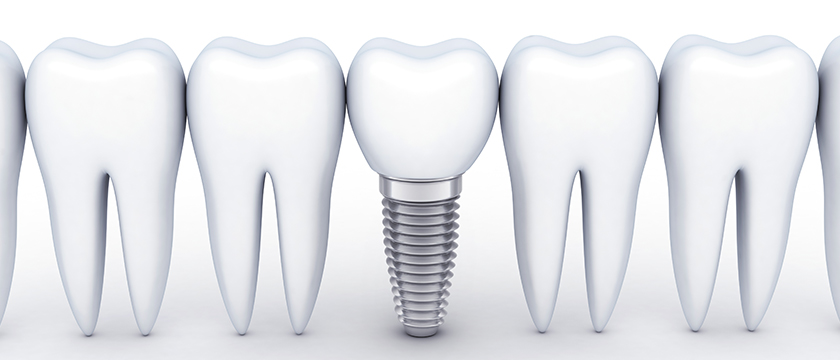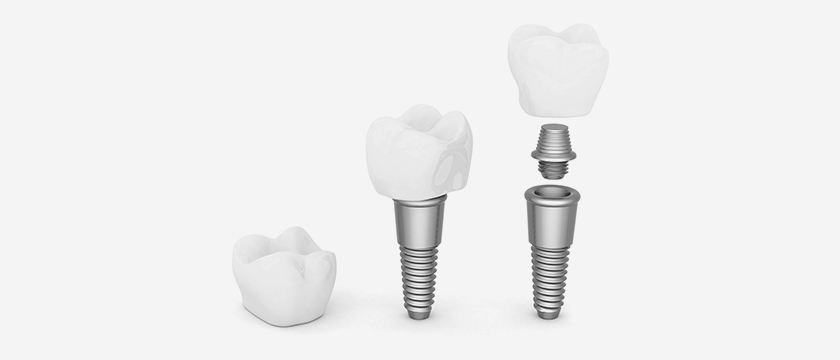If the thought of wearing partial or complete dentures for the rest of your years fills you with dread, it’s good to know options are available. If you are seeking a solution that feels natural and looks and functions like real teeth, dental implants could be a cosmetic and practical solution that’s right for you. But first of all, what are implants, and how does a dental implant work? Follow along, and we’ll tell you all there is to know about implant-based restorations and what to expect during the dental implant procedure. Of course, you can always skip the read and get a free consultation at your local dental clinic to get answers to all your questions.
What is a dental implant?
In brief, a dental implant is a substitute tooth root made from titanium and set into the jawbone to support artificial teeth. Implants can replace a single missing tooth, multiple teeth, or even all of a patient’s teeth. They can also stabilise a loose or uncomfortable denture.
So, how does a dental implant work?
Dental implants have been used successfully for over fifty years after a Swedish research team led by Dr Per Branemark discovered that bone could bond to titanium. This discovery was the start of dental implant dentistry as we know it today. Back in 1982, dental implants had a success rate of 91%. However, according to one 2018 study, the success rate of implants over 5 years was 97%.
A dental implant consists of 3 components:
- A titanium screw or post
- The abutment that connects the artificial tooth/teeth to the screw
- An artificial tooth, i.e. a dental crown or fixed bridge
The titanium screw acts as an artificial tooth root, replacing those of the missing tooth. Over time, the surrounding bone and soft tissues grow over the implant to fully integrate it into the body(osseointegration). Once the implant has stabilised, the abutment will be attached, and the restoration will be completed by screwing or cementing the artificial teeth on top.
If you’re considering dental implants, why not schedule a dental consultation near you to see if you’re a suitable candidate?
So, now we’ve answered the question, how does a dental implant work, you’re probably wondering what’s involved in the process. Let’s take a look…
What to expect during the dental implant procedure?
The entire process for dental implants can take several months as it’s carried out in various stages with waiting times between. Before going down the dental implant route, you need to find out if they are right for you (or, more specifically, for your mouth) by meeting with a dental implant dentist.
Initial consultation
For dental implants to work correctly, a person must have healthy teeth and gums and a plentiful supply of dense bone. If your oral tissues have been damaged by periodontal disease, you may not be suitable for the dental implant procedure. If your mouth is otherwise healthy and you’re in reasonably good general health, you should be eligible for the implant procedure.
Assuming you’ve got this far, the next step is to undergo a comprehensive oral examination consisting of x-rays and 3D scanning. These images enable the dental team to assess the condition of your jaw bone and determine the exact location of vital structures such as nerves and sinus cavities. Meticulous virtual planning makes surgery shorter, more comfortable, and safer for our patients. A straightforward dental implant can often be placed in under 20 minutes.
Day of the surgery
The next step of the dental implant procedure is surgery. Before commencing the process, patients will be given local anaesthesia to help them relax and ease discomfort. Here at DDSS/DDII, we use digital dental implants and computer-guided technology. A guide is placed over the teeth to protect the gums and nerves. Our dentist only needs to make minor incisions to place the implants where necessary. This means less discomfort and a shorter recovery time; patients heal faster because no sutures are needed.
 Recovery and Healing time
Recovery and Healing time
Patients now face a wait of 3 to 6 months for osseointegration to occur – when the implant and bone fuse together. Successful osseointegration is crucial if the implants are to work and function properly. Patients must exercise patience and attend regular follow-up appointments to monitor their progress.
Once the dental implants have stabilised, attaching the abutment is next. This involves another minor surgery to open the gums and reveal the implant screw. Sometimes the abutment is fitted during the first implant surgery.
Final restoration
Once the abutment is fitted, a digital impression will be taken to ensure the dental crown’s proper size, shape and colour. The crown is custom-made in our in-house lab, and once it’s ready, all that’s left to do is attach it to the abutment. Now you can sit back and admire your new smile.
How does a dental implant work for multiple missing teeth?
Fortunately, there’s no need to replace every single missing tooth with a dental implant. Instead, our dentist can replace groups of missing teeth with a fixed bridge supported by dental implants. For example, two implants can be used to support bridgework containing three or four replacement teeth, with more implants if a larger bridge is required.
Suppose you want to replace all of your teeth in the upper or lower arch or both arches? In that case, you may be eligible for same-day implant restorations, which will enable you to enjoy fully restored dentition after only one treatment.
Do you want to restore your smile?
Now you have a better understanding of how a dental implant works, why not schedule a consultation to see if they are right for you? We are a dentist that offers a free implant consultation with no obligation, so you’ve nothing to lose. Call us on (02) 8294 5812 or (02) 8294 8656 today!
Note: Any surgical or invasive procedure carries risks. Before proceeding, you should seek a second opinion from an appropriately qualified health practitioner.
References
Colgate – Implant Dentistry
https://www.colgate.com/en-za/oral-health/implants/implant-dentistry-1013#:~:text=Discovery%20of%20Dental%20Implants&text=Branemark%20discovered%20that%20bone%20can,lower%20jaw%20over%2015%20years.
PubMed Central – Implant success and survival rates in daily dental practice: 5-year results of a non-interventional study using CAMLOG SCREW-LINE implants with or without platform-switching abutments
https://www.ncbi.nlm.nih.gov/pmc/articles/PMC6212375/#
DDS Lab – Advantages and Benefits of Computer-Guided Implants
https://blog.ddslab.com/computer-guided-implant-surgery
DDS Lab – Pros and Cons of Same-Day Implants
https://blog.ddslab.com/pros-and-cons-of-same-day-dental-implants


 Recovery and Healing time
Recovery and Healing time



